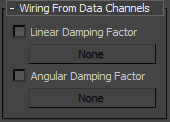mParticles Drag is a fast alternative to the mParticles Force operator for adding a slowing factor to a simulation. With the mParticles Drag operator, you don't need to first create a Drag space warp and then designate it in the mParticles Force operator. Also, mParticles Drag uses native MassFX properties to simulate friction. Last, you can use the slowing factor to stabilize the simulation (reduce jitter) and make it appear more natural, since it lets you introduce energy dissipation due to friction.
Angular and Linear damping factors specified in mParticles Drag are persistent particle properties—once the operator defines them, they are "attached" to the particles, and stay with them even as they move from event to event. Thus, to define a constant damping factor throughout the simulation, you need only a single mParticles Drag operator, set in the first event with the particles.
Interface

- Adjust
- Sets the drag mode. This option is based on the fact that you can animate the Linear and Angular Damping factors, so it's possible for them to change while particles are in the event. The available modes are:
- Continuous Adjusts the damping factors the entire time that particles are present in the event with the mParticles Drag operator. When a particle leaves the event, it retains the last damping factors that were set while it was there.
- On Event Entry Sets the damping factors once per particle, at the moment the particle enters the event, based on the current values.
For a video showing the effects of the Adjust option, see Adjust.
Damping Factor group
Toggle linear and/or angular damping, and set a separate damping value for each.
For videos showing the effects of the Damping Factor group, see Damping Factor group.
- Linear
- The slowdown factor for linear particle movement, affecting particle speed.
- Angular
- The slowdown factor for angular particle movement, affecting particle spin.
- Sync By
- When using the Continuous option, use Sync By to choose the time frame in which to apply animation of the damping factors: Absolute Time, Event Duration, or Particle Age. For details, see Animation Offset Keying group.
- Speed Factor Multiplier
- Allows an additional damping-factor adjustment, in relation to particle speed. This is useful when particles travel through a medium whose slowdown factor is proportional to the particle speed: The higher the speed, the greater the slowdown factor.
When Speed Factor Multiplier is on, the Speed Unit and Spin Unit parameters become available.
- Speed Unit
- The speed value in linear units per second at which Linear Damping is applied at the specified value (see Damping Factor, preceding). If the actual speed of a particle is twice the Speed Unit value, then the Linear Damping Factor applied is twice the specified value; it's a direct proportion. The same applies to slow particles: If a particle's actual speed is half the Speed Unit value, then the damping factor applied is half that of the specified value.
For a video showing the effects of the Speed Unit value, see Speed Unit.
- Spin Unit
- Works the same as Speed Unit but with respect to particle spin rate and the Angular Damping Factor setting. Spin Unit is measured in degrees of rotation per second.
For a video showing the effects of the Spin Unit value, see Spin Unit.
Wiring From Data Channels rollout

To access this rollout, highlight the mParticles Drag operator in the event, then right-click it and choose Use Script Wiring from the menu. This lets you define the Linear and Angular Damping Factor values per particle with a Data operator. The wiring defines damping factor values only; when Speed Factor Multiplier is on, the effect of the multiplier factor is applied on top of that.
- Linear/Angular Damping Factor
- To define either damping factor with a Data operator, turn it on, click the button and choose an Output New suboperator that uses the Real type. The suboperator defines linear or angular damping factor values on per-particle basis.